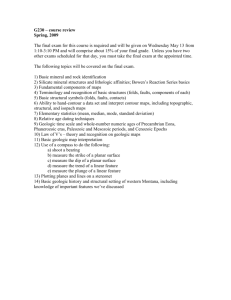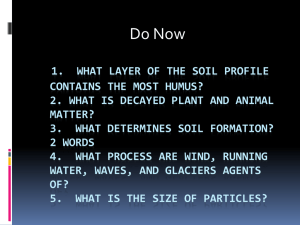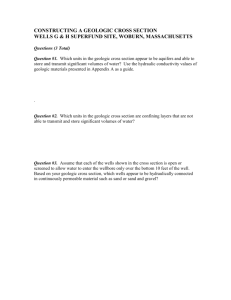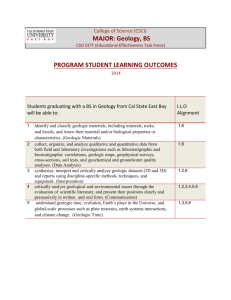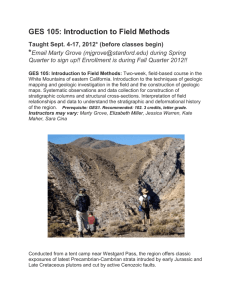GY480 Field Geology Course Final Geologic Maps and Cross-Sections
advertisement
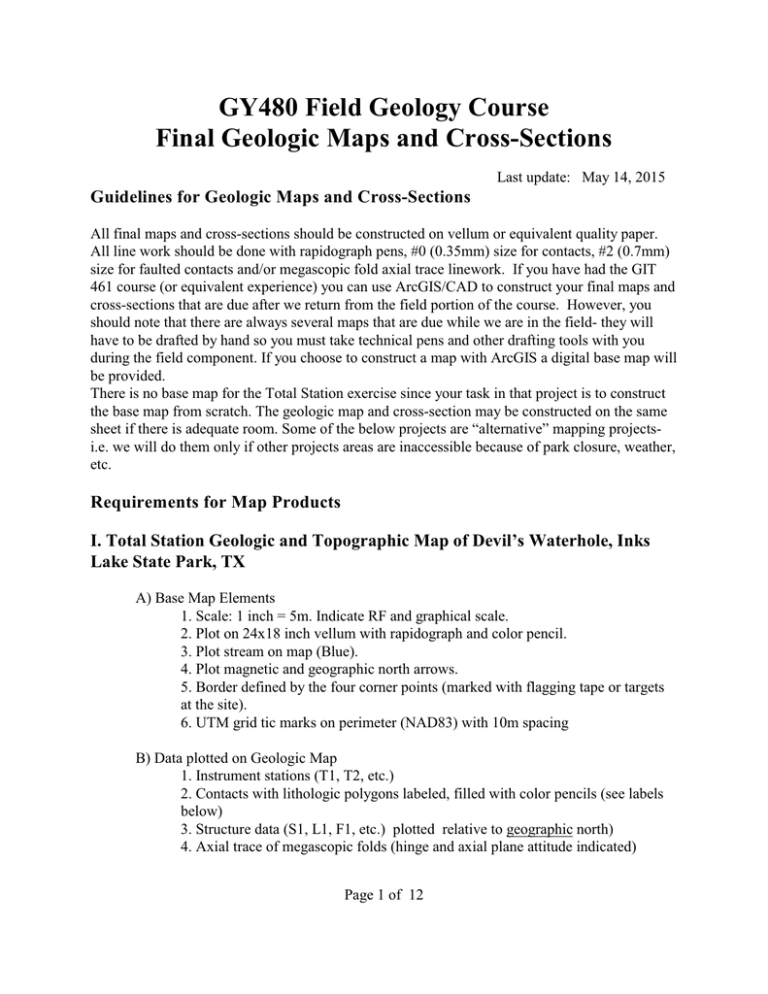
GY480 Field Geology Course Final Geologic Maps and Cross-Sections Last update: May 14, 2015 Guidelines for Geologic Maps and Cross-Sections All final maps and cross-sections should be constructed on vellum or equivalent quality paper. All line work should be done with rapidograph pens, #0 (0.35mm) size for contacts, #2 (0.7mm) size for faulted contacts and/or megascopic fold axial trace linework. If you have had the GIT 461 course (or equivalent experience) you can use ArcGIS/CAD to construct your final maps and cross-sections that are due after we return from the field portion of the course. However, you should note that there are always several maps that are due while we are in the field- they will have to be drafted by hand so you must take technical pens and other drafting tools with you during the field component. If you choose to construct a map with ArcGIS a digital base map will be provided. There is no base map for the Total Station exercise since your task in that project is to construct the base map from scratch. The geologic map and cross-section may be constructed on the same sheet if there is adequate room. Some of the below projects are “alternative” mapping projectsi.e. we will do them only if other projects areas are inaccessible because of park closure, weather, etc. Requirements for Map Products I. Total Station Geologic and Topographic Map of Devil’s Waterhole, Inks Lake State Park, TX A) Base Map Elements 1. Scale: 1 inch = 5m. Indicate RF and graphical scale. 2. Plot on 24x18 inch vellum with rapidograph and color pencil. 3. Plot stream on map (Blue). 4. Plot magnetic and geographic north arrows. 5. Border defined by the four corner points (marked with flagging tape or targets at the site). 6. UTM grid tic marks on perimeter (NAD83) with 10m spacing B) Data plotted on Geologic Map 1. Instrument stations (T1, T2, etc.) 2. Contacts with lithologic polygons labeled, filled with color pencils (see labels below) 3. Structure data (S1, L1, F1, etc.) plotted relative to geographic north) 4. Axial trace of megascopic folds (hinge and axial plane attitude indicated) Page 1 of 12 GY480 Field Geology Course Final Geologic Maps and Cross-Sections Stratigraphic Column Alluvium = Lemon Yellow (Qal) Town Mountain intrusives = Pink (pCtm) Valley Springs Paragneiss = Dark Gray (pCvsp) Valley Springs Orthogneiss = Tuscan Red (pCvso) 5. Topographic contours (0.2m interval, every 5th interval labeled as index contour) 6. Stereonets of structure data, to be plotted on separate sheets. C) Map Legend 1. Structure Symbols 2. Scale bar 3. Lithologic legend (chronological order, include brief description of unit) 4. Magnetic/Geographic north arrows (bottom center of map; note declination) 5. Title D) Notebook 1. Make sure that all data recorded in your group appears in your notebook including Total Station coordinates (i.e. everyone will have a total copy of all collected data in their notebook). Summary of products to turn in: 1. Combined Geologic and Topographic Map of Project Area 2. Stereonets of Structure Data collected at site annotated with fold hinge, axial plane, etc. . II. Geologic Map and Cross-section of Inks Lake State Park and Murchison Ranch, TX, Area A) Base Map Features to Draft on Geologic Map 1. Scale: 1:12,000 (1 inch = 1000 feet) 2. Index Contours and Labels (100 foot interval; see base map) 3. Roads inside the Map Area 4. Mapping Area Boundary 5. Lakes and streams (Blue) 6. UTM grid (NAD83) Page 2 of 12 GY480 Field Geology Course Final Geologic Maps and Cross-Sections B) Plotted Data on Geologic Map 1. Lithologic/Structural contacts Stratigraphic Column Alluvium (Quaternary) Canary Yellow (Qal) Tanyard Formation(Ordovician)= pink (Ot) NOTE: Tanyard Formation and San Saba Member may be combined as (COt/ss) tan Williston Formation San Saba Member = tan (Cws) Point Peak Member =gray (Cwpp) Morgan Creek Member = Light Green (Cwm) Welge Member = Olive(Cww) Riley Formation Lion Mt. Member = Green (Crl) Cap Mt. Member = Blue (Crc) Hickory Sandstone Member = Dark Brown (Cwh) Precambrian Crystalline Rocks Town Mountain intrusives = Pink (pCtm) Honey Formation = Royal Blue (pCh) Valley Springs Paragneiss = Dark Gray (pCvsp) Valley Springs Orthogneiss = Tuscan Red (pCvso) 2. Structure Data (S1, L1, F1, etc.) 3. Megascopic Structures (Axial trace, Faults, etc.) 4. Stereonets of structure data, contoured if > 50 elements. Stereonets may be submitted as separate sheets or plotted on the map. 5. Title and authors (team members) 6. Plot map on 24x36" vellum or similar material with rapidograph and color pencil. C) Map Legend 1. Structure Symbols 2. Scale bar 3. Lithologic legend (chronological order, include brief description of unit) 4. Magnetic/Geographic north arrows (bottom center of map; note declination) 5. Title D) Cross-section 1. VE = 1.0 Page 3 of 12 GY480 Field Geology Course Final Geologic Maps and Cross-Sections 2. Same color code and lithologic legend as geologic map (cross-section map be combined with geologic map if room allows. 3. Label as A-A’ on geologic map (see base map): Point A: intersection of unimproved road and transmission line on the crest of Long Mt. Point A’: intersection of east park boundary fence and Spring Creek 4. Include topographic profile 5. Interpolate geology below Inks Lake. 6. Vertical scale with elevation intervals labeled. 7. Indicate fault motion with displacement arrows. 8. Indicate foliation direction in metamorphic rocks with “squiggly” lines. Notebooks for teams will be checked for consistency. Make sure your notes are re-copied neatly, and are organized by station label. All GPS coordinates should be recorded. All members of a group should have a complete copy of all data collected. Summary of products to turn in: 1. Geologic Map of the Inks Lake and Vicinity Project Area 2. Cross-section A-A’ of the Inks Lake and Vicinity Project Area 3. Stereonet Plots of data collected during project III. Geologic Map and Cross-Section of the Copper Hill, NM, Area A) Base Map Features to Draft on Geologic Map 1. Scale: 1:12,000 (1 inch = 1000 feet) 2. Index Contours(100 foot interval) 3. Road and trail systems 4. Streams and Lakes (Blue) 5. Prominent Mountain peaks 6. Mines 7. Map Area Boundary (see base map) 8. Magnetic and Geographic North 9. UTM grid (NAD83) B) Plotted Data on Geologic Map 1. Lithologic/Structural contacts Stratigraphic Column Santa Fe Group sand, gravel, and volcanics = Vermillion (Ts) Page 4 of 12 GY480 Field Geology Course Final Geologic Maps and Cross-Sections Marquenas Formation metaconglomerate, quartzite, and schist = Dark Brown (pCm) Pilar Formation graphitic slate, phyllite, and garnet schist = Dark Gray (pCp) Rinconada Formation garnet staurolite schist and quartzite = Sea Green (pCr) Ortega Formation massive malachite-bearing andalusite quartzite = Lemon Yellow (pCo) 2. Structure Data 3. Megascopic Structural Trends (Axial trace, Faults, etc.) 4. Stereonets of structure data, contoured if > 50 elements 5. Plot map on 18x24" vellum or similar material with rapidograph and color pencil. C) Map Legend 1. Structure Symbols 2. Scale bar 3. Lithologic legend (chronological order, include description of units) 4. Magnetic/Geographic north arrows (bottom center of map; note declination) 5. Title 6. Authors (group members) D) Cross-section 1. VE = 1.0 2. Same color code and lithologic legend as geologic map 3. Label as A-A’ on geologic map: Point A: northwest corner of map area Point A’:southern map area boundary such that the cross-section line passes through Cerro de las Marquenas 4. Include topographic profile. 5. Vertical scale and elevation labels. E) Notebooks should be consistent among team members. Summary of products to be turned in: 1. Geologic Map of the Copper Hill Project Area. 2. Cross-section A-A’ of the Copper Hill Project Area. 3. Stereonet plots of data. Page 5 of 12 GY480 Field Geology Course Final Geologic Maps and Cross-Sections IV. San Ysidro Area Geologic Map and Cross-section A. Base Map information to Draft on Geologic Map 1. Scale: 1:12,000 (1 inch = 1000 feet) 2. Index Contours(100 foot interval) 3. Road and trail systems 4. Streams (Blue) 5. Prominent Mountain peaks, benchmarks, and spot elevations. 6. Map Area Boundary 7. UTM grid (NAD83) B) Plotted Data on Geologic Map 1. Lithologic/Structural contacts Stratigraphic Column Quaternary Alluvium (Qal) = Canary Yellow Quaternary Travertine (Qt) = Lt. Gray Quaternary Pediment (Qp) = Lavender Mancos Formation shale (Km) = Lt. Green Dakota Formation sandstone (Kd) = Lemon Yellow Morrison Formation sandstone and shale (Jm) = Orange Todilto Formation evaporite (Jt) = Indigo Blue Entrada Formation sandstone (Je) = Pink Chinle Formation sandstone (Tch) = Sienna Brown 2. Structure Data 3. Megascopic Structural Trends (Axial trace, Faults, etc.) 4. Stereonets of structure data, to be plotted on separate sheets. 5. Plot map on 18x24" vellum or similar material with rapidograph and color pencil. C) Map Legend 1. Structure Symbols. 2. Scale bar. 3. Lithologic legend (chronological order, include brief description of unit). 4. Magnetic/Geographic north arrows (bottom center of map; note declination). 5. Title. 6. Authors. Page 6 of 12 GY480 Field Geology Course Final Geologic Maps and Cross-Sections D) Cross-section 1. VE = 1. 2. Same color code and lithologic legend as geologic map. 3. Label as A-A’ on geologic map. 4. Include topographic profile. 5. Vertical scale and elevation reference marks. E) Notebooks should be consistent among team members. Summary of products to turn in: 1. Geologic Map of the San Ysidro Project Area 2. Cross-section A-A’ of the San Ysidro Project Area 3. Stereonet plots of data collected. VI. Geologic Map and Cross-Section of the Box Canyon, NM Area A) Base Map Features to Draft on Geologic Map 1. Scale: 1:12,000 (1 inch = 1000 feet) 2. Index Contours(100 foot interval) 3. Road and trail systems 4. Streams (Blue) 5. Prominent Mountain peaks 6. Mines 7. Map Area Boundary 8. UTM grid (NAD83) B) Plotted Data on Geologic Map 1. Lithologic/Structural contacts Stratigraphic Column Quaternary Alluvium = Lemon yellow (Qal) Tertiary Volcanics/Volcanoclastics = Lt. Green (Tv) Flechado formation = Olive (|Pf) Terrero formation = Sky blue (Mt) Espiritu Santo formation =Purple (Me) Del Padre formation = Tan (Md) Precambrian Embudo granite = pink (pCe) Page 7 of 12 GY480 Field Geology Course Final Geologic Maps and Cross-Sections 2. Structure Data 3. Megascopic Structural Trends (Axial trace, Faults, etc.) 4. Stereonets of structure data, contoured if > 50 elements 5. Plot map on 18x24" vellum or similar material with rapidograph and color pencil. C) Map Legend 1. Structure Symbols 2. Scale bar 3. Lithologic legend (chronological order, include brief description of unit) 4. Magnetic/Geographic north arrows (bottom center of map; note declination) 5. Title D) Cross-section 1. VE = 1.0 2. Same color code and lithologic legend as geologic map 3. Label as A-A’ on geologic map: Point A: see base map Point A’: see base map 4. Include topographic profile. 5. Vertical scale and elevation reference marks. E) Notebooks should be consistent among team members Summary of products to be turned in: 1. Geologic Map of the Box Canyon Project Area. 2. Cross-section A-A’ of the Box Canyon Project Area. 3. Stereonet plots of data. IV. North Kaibab Trail of the Grand Canyon, AZ, Area Geologic Map and Cross-section A. Base Map information to Draft onto the Geologic Map 1. Scale: 1:12,000 (1 inch = 1000 feet) 2. Road and trail systems 3. Streams (Blue) 4. Map Area Boundary 5. Geographic & Magnetic North (with declination indicated) 6. UTM grid (NAD83) Page 8 of 12 GY480 Field Geology Course Final Geologic Maps and Cross-Sections B) Plotted Data on Geologic Map 1. Lithologic/Structural contacts Stratigraphic Column Kaibab Limestone (Pk) = Ultramarine Blue Toroweap Evaporites (Pt) = Orange Coconino Sandstone (Pc) = Lemon Yellow Hermit Shale (Ph) = Siena Brown Supai Group (|Ps) = Lt. Green Redwall Limestone (Mr) = Scarlet Red Muav Limestone (-Cm) = Purple Bright Angel Shale (-Cb) = Grass Green 2. Structure Data (including crossbedding measurements) 3. Megascopic Structural Trends (Axial trace, Faults, etc.) 4. Plot map on 18x24" vellum or similar material with rapidograph and color pencil. C) Map Legend 1. Structure Symbols. 2. Scale bar. 3. Lithologic legend (chronological order, include brief description of unit). 4. Magnetic/Geographic north arrows (bottom center of map; note declination). 5. Title. D) Cross-section 1. VE = 1. 2. Same color code and lithologic legend as geologic map. 3. Label as A-A’ on geologic map. 4. Include topographic profile. 5. Vertical scale and elevation reference marks. E) Notebooks should be consistent among team members. Summary of products to turn in: 1. Geologic Map of the North Kaibab Trail Project Area 2. Cross-section A-A’ of the North Kaibab Trail Project Area V. Geologic Map of Palo Duro Canyon State Park, TX Page 9 of 12 GY480 Field Geology Course Final Geologic Maps and Cross-Sections A. Base Map information to Draft onto the Geologic Map 1. Scale: 1:24,000 (1 inch = 2000 feet) 2. Map Area Boundary = State Park Boundary line 3. Geographic & Magnetic North (with declination indicated) 4. UTM grid (NAD27) B) Plotted Data on Geologic Map 1. Lithologic/Structural contacts Stratigraphic Column Quaternary Alluvium (Qal) = Yellow Ogalallo Evaporite (Qo) = Light Blue Trujillo Formation (Trtr) = Light Green Tecovas Formation (Trte) = Pink Quartermaster Formation (Pq) = Red 2. Structure Data (including crossbedding measurements) 3. Megascopic Structural Trends ( Faults, etc.) 4. Plot map on 18x24" vellum or similar material with rapidograph and color pencil. C) Map Legend 1. Structure Symbols. 2. Scale bar. 3. Lithologic legend (chronological order, include brief description of unit). 4. Magnetic/Geographic north arrows (bottom center of map; note declination). 5. Title. D) Notebooks should be consistent among team members. Summary of products to turn in: 1. Geologic Map of Palo Duro Canyon State Park, TX II. Geologic Map and Cross-section of Cheaha State Park and Vicinity A) Base Map Features to Draft on Geologic Map 1. Scale: 1:12,000 (1 inch = 1000 feet) 2. Roads/Trails inside the Map Area 3. Mapping Area Boundary 4. Lakes and streams (Blue) Page 10 of 12 GY480 Field Geology Course Final Geologic Maps and Cross-Sections 5. UTM grid tic marks (NAD27) B) Plotted Data on Geologic Map 1. Lithologic/Structural contacts Stratigraphic Column Alluvium (Quaternary) Canary Yellow (Qal) Hillabee Greenstone (Devonian (?) ) Olive green (D(?)hgs) Jemison Chert/Erin Slate (Devonian) Pink (Dtjc/Dtes) Cheaha Quartzite (Siluro-Devonian) Purple (S-Dtcq) Lay Dam Formation (Siluro-Devonian) Light Green Poe Bridge Mt. Group (Neoproterozoic) Tan (p-Cpbm) 2. Structure Data (Bedding,S1, L1, F1, etc.) 3. Megascopic Structures (Axial trace, Faults, etc.) 4. Stereonets of structure data, contoured if > 50 elements. Stereonets may be submitted as separate sheets or plotted on the map. 5. Title and authors (team members) 6. Plot map on 24x36" vellum or similar material with rapidograph and color pencil. C) Map Legend 1. Structure Symbols 2. Scale bar 3. Lithologic legend (stratigraphic order, youngest on top. Include brief description of unit) 4. Magnetic/Geographic north arrows (bottom center of map; note declination) 5. Title D) Cross-section 1. VE = 1.0 2. Same color code and lithologic legend as geologic map (cross-section map be combined with geologic map if room allows. 3. Label as A-A’ on geologic map (see base map): 4. Include topographic profile 5. Vertical scale with 200m elevation intervals labeled. 6. Indicate fault motion with displacement arrows. 7. Indicate foliation direction in metamorphic rocks with “squiggly” lines. Notebooks for teams will be checked for consistency. Make sure your notes are re-copied neatly, Page 11 of 12 GY480 Field Geology Course Final Geologic Maps and Cross-Sections and are organized by station label. All GPS coordinates should be recorded. All members of a group should have a complete copy of all data collected. Summary of products to turn in: 1. Geologic Map of the Cheaha State Park, AL, and Vicinity Project Area 2. Cross-section A-A’ of the Cheaha State Park and Vicinity Project Area 3. Stereonet Plots of data collected during project Page 12 of 12
